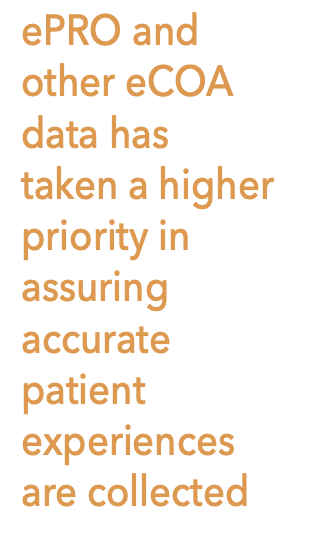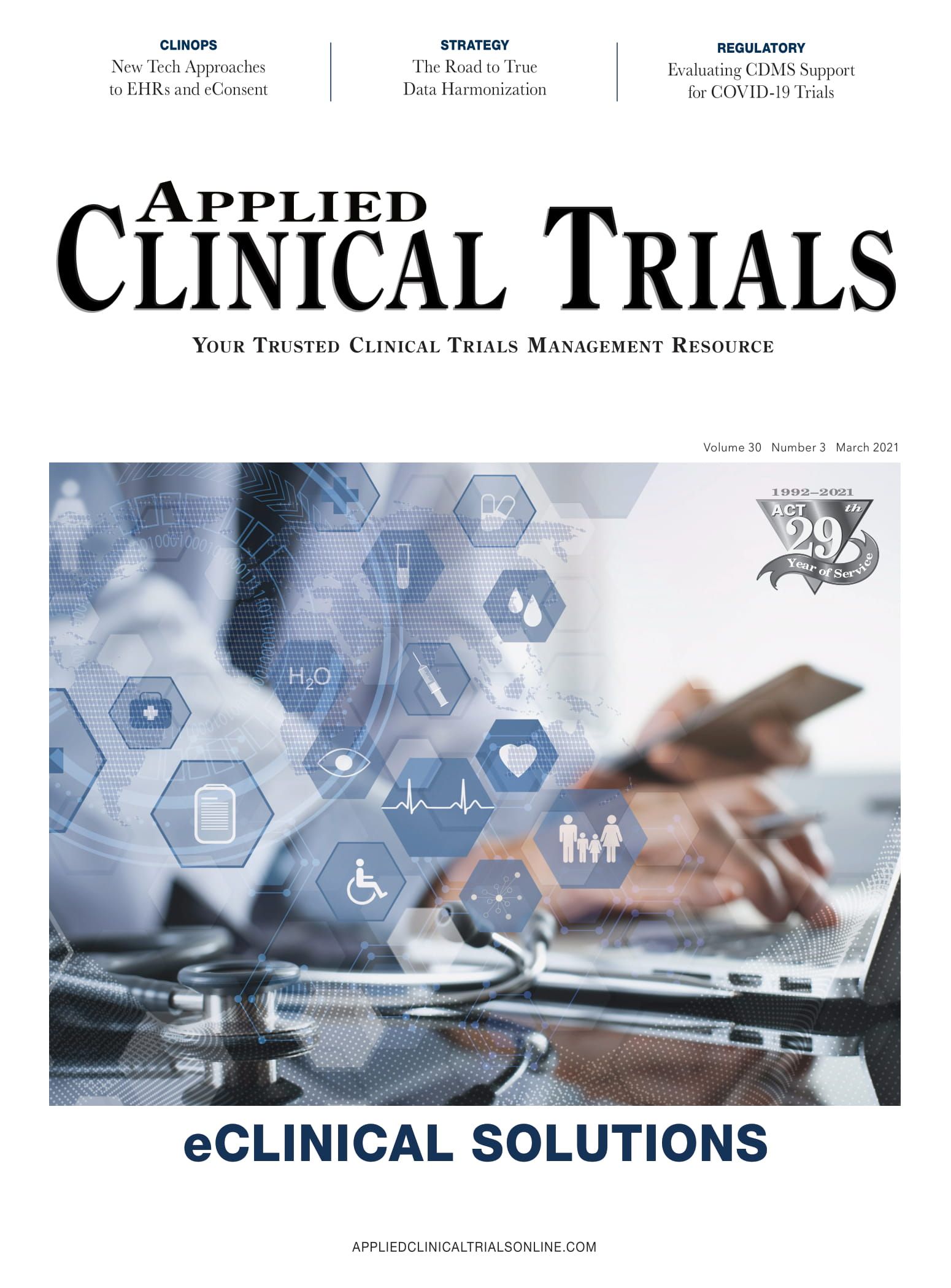ePRO and Ensuring Data Integrity
Push for accurate data collection during pandemic led by increased focus on patient engagement.

ePRO (electronic patient-reported outcome) approaches in clinical trials have been around for quite some time but it has taken a pandemic, with time of the essence, to give a boost to wider deployment. The proliferation and acceptance of digital devices and wearables by regulators, clinicians and patients has helped to fuel this opportunity for remote monitoring and will help to bring clinical trials further into the 21st century.
An increased focus on patient engagement and the 21st Century Cures Act, regulatory authorities, i.e., the FDA, are embracing the need for more patient-centric drug development and wider access to assure accurate data collection as trials become more decentralized.
For example, one of our partners, a market leader, is currently running 17 COVID studies with ePRO. These studies are being conducted in more than 38 countries with sites of up to 400 and patient counts of up to the tens of thousands. Another partner is conducting 15 COVID studies with ePRO, indicating that the market is confident in providing more patient-centric alternatives to the traditional trial model.
ePRO and other eCOA (electronic clinical outcome assessment) data has thus taken a higher priority in assuring accurate patient experiences are collected. However, this data goes through a process of validation measures in order to be used as a primary endpoint in drug development and trial evaluations.

Using technological advances
With the continuous mutations of SARS CoV-2, drug developers are met with the challenges of determining the efficacy of current vaccines against the emerging strains. Along with embracing new technologies, there is a need to adapt trials to accommodate social distancing and to keep patients safe while still collecting necessary information.
The focus on improved visibility and oversight of data collection, faster trial implementation, sharing of real-time data and patient comfort and collaboration has led to a variety of eClinical applications. ePRO and other eCOA approaches can transform trials to make them more pragmatic, patient-centric and efficient by maximizing the potential to quickly access data through electronic health records, and especially to assist trial managers to make reliable data-driven decisions, and to mitigate risks.
The technology used to gather ePRO can be a downloadable app configurable to any digital device. The app provides the ability to record responses to trial questions as well as create photos or videos. With provisioned devices, the technology is usually preloaded. The technology may also include features to help improve patient compliance, such as reminder alarms.
Supporting these opportunities are the introduction of wearable devices like fitness trackers bringing, yet again, another opportunity to expand patient engagement in clinical trials. As wearables can be considered a BYOD (bring your own device), there is, as of yet, an unclear path as to which is the sponsor’s preferred method, i.e., BYOD versus the provisioning of a device. A number of factors can contribute to this depending on the trial, cost implication and privacy/security concerns. There could be potential issues with regards to carrying an additional device or using data from an individual’s personal data plan—all important considerations.
Data science teams have developed dashboards, visualizations and analyses to enable effective safety and trial risk management. This alleviates some of the concerns associated with BYOD where participants are able to turn off or change their notification settings, which could lead to missing data points. These tools. i.e. dashboards, would reassure sponsors that sites can track compliance and potentially improve outcomes by reminding participants via telephone contact or text messages to improve participant engagement.
Some sponsors have opted for a partially decentralized eCOA approach where the patient will visit a central site for major assessments but will also have home visits performed by trained nurses. This limits the number of visits to the central site and helps ensure patients are complying with protocols and are comfortable using the digital device whether it be a wearable device or more traditional ePRO device. This option is enabled by making the most of ePRO and other eCOA applications. One of the major upsides to monitoring in hybrid or remote trials is the opportunity to engage wider global patient participation, ensuring the trials are representative of a larger and more diverse population. Either way, mitigation or even elimination of travel can be a boon for both patients, who can self-monitor in a comfortable setting, and trial monitors, who are often on the road covering vast geographic areas.
Ensuring data integrity
As beneficial as these new technologies are becoming to streamline trial data integrity, privacy and security are all of paramount priority.
Clinical Data Management (CDM) teams have a crucial role in a successful clinical trial–a role that must ensure the production of quality, accurate and comprehensive clinical data to meet safety and efficacy standards to pass review by regulators. Modern techniques are emerging in the application of data science tools and technologies to support data validation and reporting, and these are proving very effective in identifying any untruths in that data. One of these tools is the application of artificial intelligence (AI) and the development of visualizations to deliver insights, drive efficiencies and add substantial value to the clinical trial process. The CDM approach considers five essential data elements: data volume, variety, velocity, veracity and value. The data science techniques support CDM in these areas via the exploration, application and development of different technologies and approaches.
Artificial Intelligence and Machine Learning (ML) inspire real data-driven decisions. For the trial sponsor, the application of AI/ML techniques uses historical data that can be easily factored into data moving forward. For example, there are algorithms, which can help to identify profiles, for example gender, race, ethnicity, of the different types of participants in the trial and use existing data to engage the patient to exhibit the correct behavior, i.e., follow procedures. ePRO, too offers a huge bank of data and some creative trial managers have even applied gaming techniques to inspire patients to stay engaged. This can help with both current participant behavior as well as for the future participant. Currently historical data is being used to help future participant behavior. As the amount of data increases over time in trials for specific indications, then the algorithms can generate much better insight to aid current participant behavior, as close to real-time as possible.
After identifying variables and other data, AI can identify common issues where automation could benefit the data cleaning process and with a rule-based approach, identify potential data quality issues. Data science methods, such as AI, can auto-detect potential hot-spots of data inconsistencies and potential anomalies. Working with experts, a rule-based approach can be applied to these hot-spots to highlight potential data anomalies, driving efficiencies in the overall data cleaning process.
AI/ML techniques are already in existence but generally pharma companies have been slow to embrace them for a variety of reasons, including concerns about regulatory compliance. The pandemic, however, has accelerated their adoption. In the area of event prediction, a trial manager can look into a company’s historical clinical trial data and provide data guidance when for example, writing new protocols, i.e., for dosages that may need to be increased/reduced for trials in different geographic areas or age groups. At an organizational level, advice can be given to the sponsor based on a virtual trial conducted with historical data. At the patient level, these techniques can predict adverse events causality–before they happen.
Remote, risk-based monitoring has increased and shows a great deal of success with these strategies, particularly if there is a remote monitoring platform integrated into a visualization platform to verify what is critical and what is not. Customized visualization platforms improvedata integrity and security for each trial.
Mitigating the cost of trials
Clinical trial costs are highly dependent on a long list of factors that can vary substantially but it has been noted that late-stage clinical trials can sometimes comprise as much as 50% or more of the cost of bringing a drug to market. At the highest levels, factors can include the geographic expanse of trial locations as well as the complexities of the drug engaged in the trial. Hold-ups due to data reconciliation, common mistakes in data input and reporting errors, quality and regulatory actions that could put a trial on hold, can certainly impact the success of a trial.
It makes good sense for sponsors to continue to embrace and invest in existing and new technologies that bring cost-saving potential and an opportunity for wider patient engagement. The future is bright for ePRO data collection and it may have taken a pandemic to bring new ways to ensure its ongoing success.
Sachin Bharadia, Account Manager, PHASTAR
